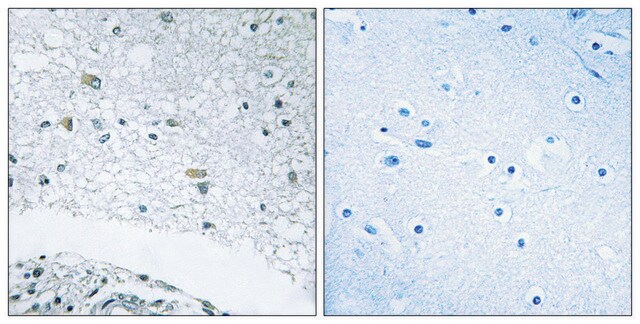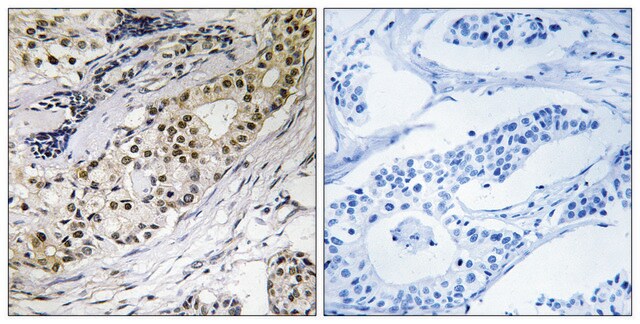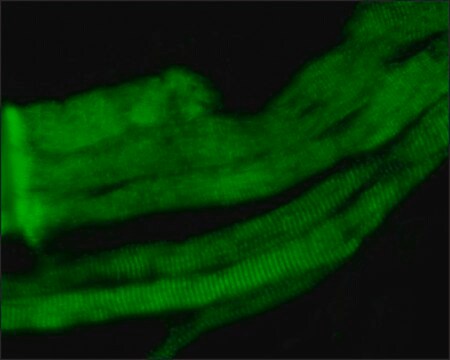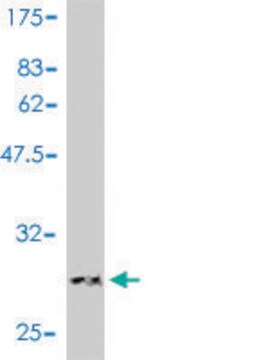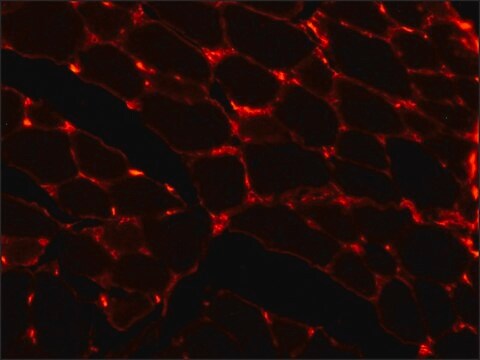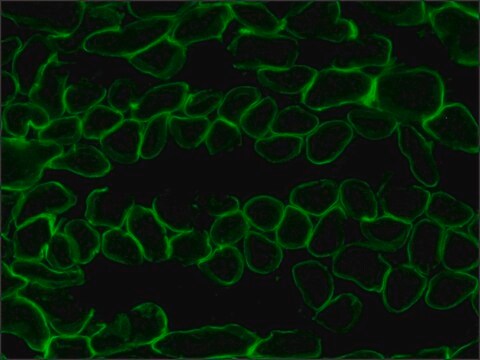MAB1914P
Anti-Laminin gamma 1 Antibody, clone A5
clone A5, Chemicon®, from rat
Synonym(s):
LAMC1
Sign Into View Organizational & Contract Pricing
Select a Size
All Photos(2)
Select a Size
Change View
About This Item
UNSPSC Code:
12352203
eCl@ss:
32160702
NACRES:
NA.41
Recommended Products
General description
Laminins, a family of extracellular matrix glycoproteins, are the major noncollagenous constituent of basement membranes. They have been implicated in a wide variety of biological processes including cell adhesion, differentiation, migration, signaling, neurite outgrowth and metastasis. Variations in the expression of laminins have been observed in embryogenesis, organogenesis, post traumatic healing and cancer. Laminins have been provoked by the discovery of their ability to promote neurite regeneration. Laminins are composed of 3 non identical chains: laminin alpha, beta and gamma (formerly A, B1, and B2, respectively). The gamma 1 chain, formerly thought to be a beta chain, contains structural domains similar to beta chains, however, lacks the short alpha region separating domains I and II. Embryos of transgenic mice in which both alleles of the gamma 1 chain gene were inactivated by homologous recombination, lacked basement membranes, indicating that laminin, gamma 1 chain is necessary for laminin heterotrimer assembly.
Immunogen
Basement membrane protein preparation from mouse EHS tumor.
Application
Detect Laminin gamma 1 using this Anti-Laminin gamma 1 Antibody, clone A5 validated for use in IH(P).
Research Sub Category
ECM Proteins
Adhesion (CAMs)
ECM Proteins
Adhesion (CAMs)
Target description
177 kDa
Physical form
Format: Purified
Purified rat immunoglobulin in buffer containing 0.1M Tris-Glycine (pH7.4) 150mM NaCl with 0.05% NaN3.
Analysis Note
Control
Tubular carcinoma of the colon and fibroneuroma
Tubular carcinoma of the colon and fibroneuroma
Other Notes
Concentration: Please refer to the Certificate of Analysis for the lot-specific concentration.
Legal Information
CHEMICON is a registered trademark of Merck KGaA, Darmstadt, Germany
Not finding the right product?
Try our Product Selector Tool.
Storage Class
12 - Non Combustible Liquids
wgk_germany
WGK 1
flash_point_f
Not applicable
flash_point_c
Not applicable
Certificates of Analysis (COA)
Search for Certificates of Analysis (COA) by entering the products Lot/Batch Number. Lot and Batch Numbers can be found on a product’s label following the words ‘Lot’ or ‘Batch’.
Already Own This Product?
Find documentation for the products that you have recently purchased in the Document Library.
Henry J Bonilla et al.
GeroScience, 42(6), 1431-1443 (2020-09-19)
Analysis of skeletal muscle mass and composition is essential for studying the biology of age-related sarcopenia, loss of muscle mass, and function. Muscle immunohistochemistry (IHC) allows for simultaneous visualization of morphological characteristics and determination of fiber type composition. The information
Jungbum Kim et al.
Journal of microbiology and biotechnology, 34(1), 157-166 (2024-01-29)
Sarcopenia is an age-related loss of muscle mass and function for which there is no approved pharmacological treatment. We tested direct efficacy by evaluating grip strength improvement in a sarcopenia mouse model rather than drug screening, which inhibits specific molecular
Raphael Reuten et al.
Nature materials, 20(6), 892-903 (2021-01-27)
The basement membrane (BM) is a special type of extracellular matrix and presents the major barrier cancer cells have to overcome multiple times to form metastases. Here we show that BM stiffness is a major determinant of metastases formation in
Fenny Wiradjaja et al.
Disease models & mechanisms, 6(6), 1426-1433 (2013-09-21)
Fras1-related extracellular matrix protein 1 (FREM1) is required for epidermal adhesion during embryogenesis, and mice lacking the gene develop fetal skin blisters and a range of other developmental defects. Mutations in members of the FRAS/FREM gene family cause diseases of
Daniel Öhlund et al.
BMC cancer, 13, 154-154 (2013-03-28)
Pancreatic cancer shows a highly aggressive and infiltrative growth pattern and is characterized by an abundant tumor stroma known to interact with the cancer cells, and to influence tumor growth and drug resistance. Cancer cells actively take part in the
Our team of scientists has experience in all areas of research including Life Science, Material Science, Chemical Synthesis, Chromatography, Analytical and many others.
Contact Technical Service